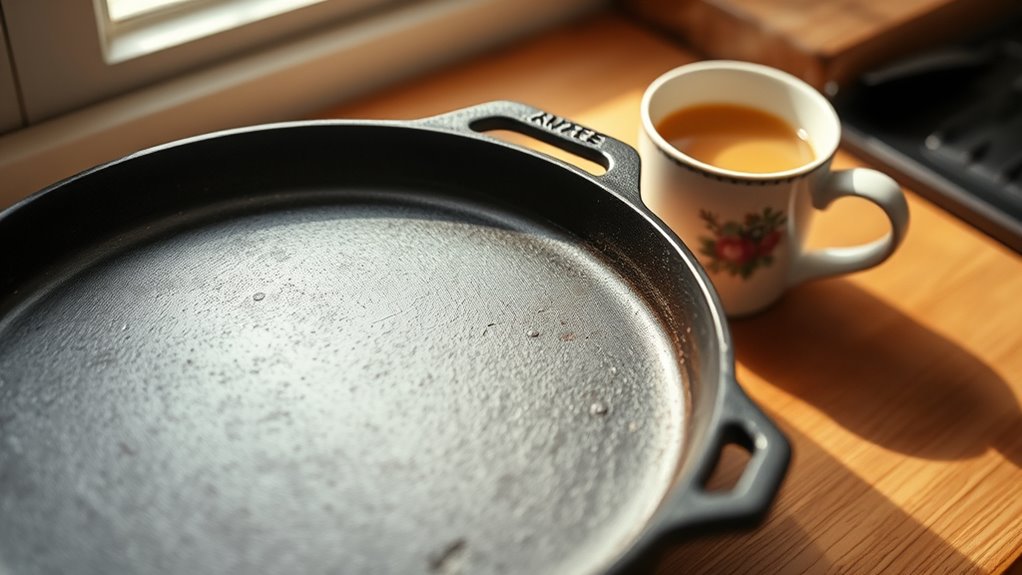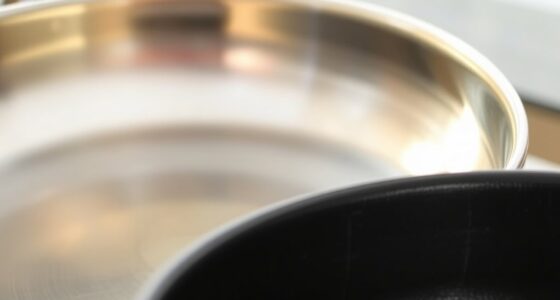Seasoning your cast iron creates a durable, non-stick surface through a chemical bond formed when heated oil polymerizes on the metal. To do this right, you need to choose high-smoke-point oils like flaxseed or grapeseed, apply thin, even coats, and heat gradually for best results. Proper preparation, temperature control, and maintenance are key to avoiding common mistakes like rust or sticky spots. If you want to master these techniques, there’s more to discover below.
Key Takeaways
- Proper seasoning creates a durable, non-stick surface through chemical bonding of oil and metal, improving with use over time.
- Use high-smoke-point oils like flaxseed or grapeseed for effective polymerization and long-lasting seasoning.
- Apply thin, even oil layers and heat gradually to prevent uneven build-up, flaking, or sticky spots.
- Regular maintenance, including cleaning without soap and re-seasoning when needed, prolongs cast iron’s lifespan.
- Temperature control and understanding heat variability are crucial for optimal seasoning, durability, and preventing damage.
The Science Behind Seasoning: Why It Matters
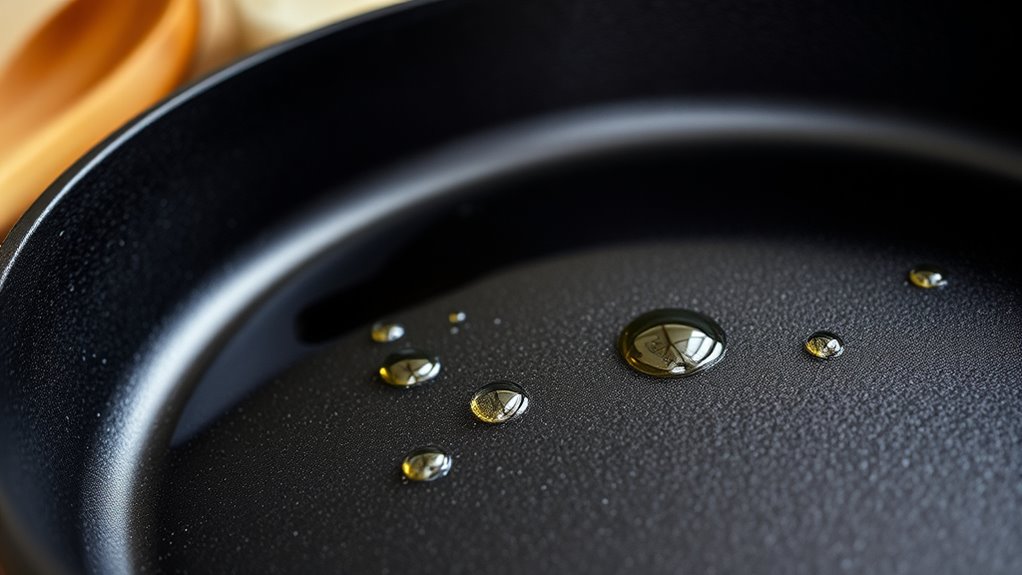
Understanding the science behind seasoning helps you appreciate why it’s essential for your cast iron skillet. When you heat oil on the skillet’s surface, it creates a bond that prevents metal oxidation, which can cause rust and damage. This process promotes seasoning adhesion, allowing a durable, non-stick layer to form over time. Proper seasoning fundamentally builds a protective coating that gets better with each use. Without this layer, your skillet remains vulnerable to moisture and corrosion. The key is applying a thin, even layer of oil that bonds well with the metal during heating. This chemical reaction transforms the oil into a hard, slick surface, ensuring your cast iron stays in top condition and performs beautifully for years. Additionally, understanding how oil polymerization occurs during heating can help you choose the best oils for seasoning.
Choosing the Right Oils for a Perfect Coat
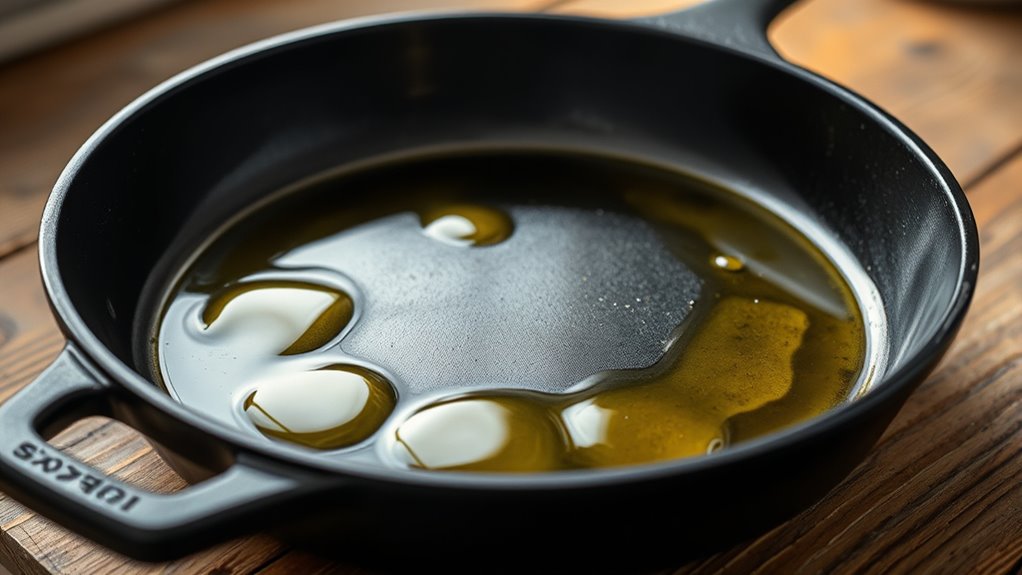
Choosing the right oil is essential for creating a durable, non-stick seasoning on your cast iron skillet. The type of oil you select impacts oil absorption and seasoning adhesion. High-smoke-point oils, like flaxseed or grapeseed, polymerize better, forming a stronger, more resilient coating. These oils resist burning during seasoning, ensuring a smooth, even layer. Avoid thin or watery oils, which tend to absorb unevenly or create a patchy finish. The goal is to build layers that bond well with the cast iron surface, so pick oils that promote excellent seasoning adhesion. Using oils with high polymerization properties can significantly improve the durability of your seasoning layer. Remember, the right oil enhances the seasoning process, leading to a surface that’s easier to cook on and more resistant to rust over time.
Step-by-Step: How to Properly Prepare Your Cast Iron
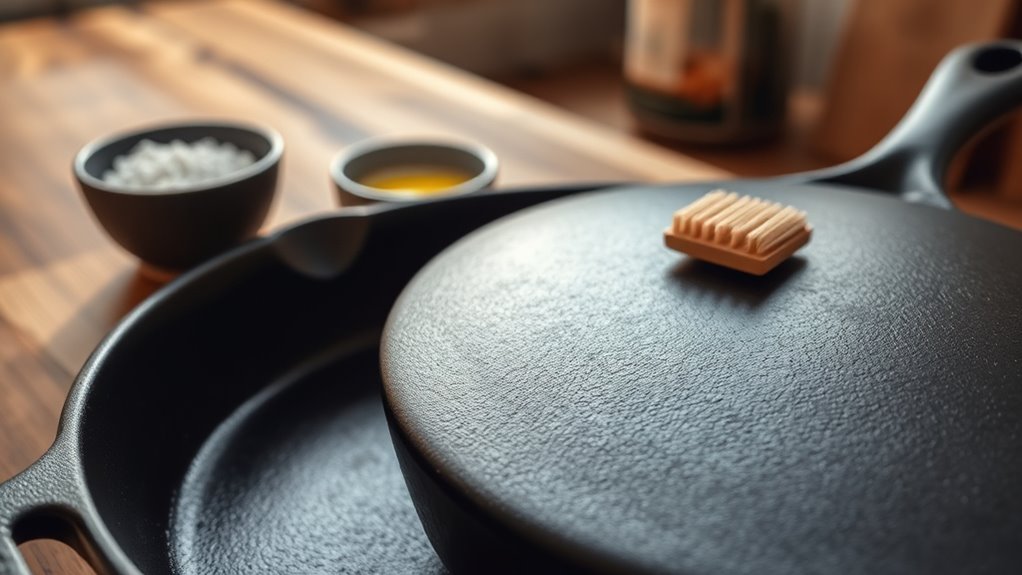
Before you begin seasoning your cast iron, it’s important to properly clean and dry the cookware to remove any dirt, rust, or old seasoning. This step guarantees ideal oil absorption and maximizes seasoning longevity. Start by scrubbing the surface with hot water and a stiff brush or steel wool. Dry thoroughly with a clean towel or by heating on the stove. Once dry, consider applying a thin layer of oil, ensuring even coverage across all surfaces. To prepare for seasoning, follow these steps:
- Remove any residual rust or debris
- Ensure the surface is completely dry
- Apply a very thin, even coat of oil
- Preheat your oven to the recommended temperature
- Paying attention to seasoning layers helps build a durable non-stick surface over time
Proper preparation promotes a durable, well-seasoned finish that improves performance over time.
The Myth of the “Perfect” Temperature: Finding Your Ideal Heat
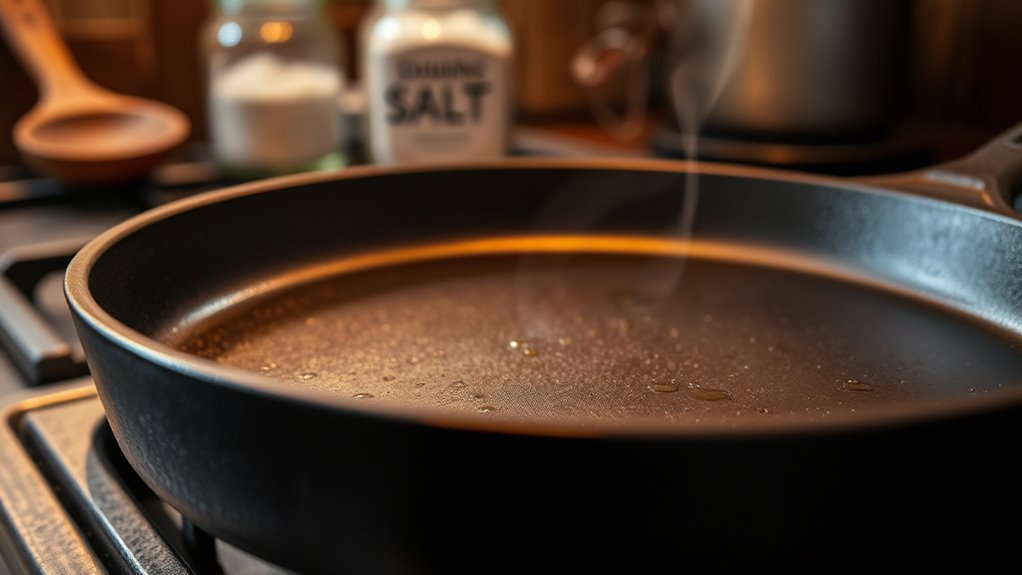
You might think there’s a perfect temperature for seasoning your cast iron, but it really depends on several factors. Heat variability, your personal cooking style, and the smoke point of your oil all influence how hot you should go. Finding your ideal heat means understanding these elements and adjusting as needed. Additionally, inspirational quotes about fatherhood can remind us that patience and adaptability are key virtues, much like mastering the nuances of seasoning cast iron.
Heat Variability Factors
Many cooks believe there’s a single “perfect” temperature for seasoning cast iron, but in reality, heat variability influences your results. Temperature fluctuation during heating and cooling cycles can affect how well the oil bonds to the pan’s surface. Additionally, the heat source variety—gas, electric, or induction—creates different heating patterns that impact seasoning quality. Maximize Space and Organization factors such as uneven heat distribution from different stovetops and rapid temperature changes causing stress on the metal can also influence the seasoning process. Understanding these variables helps you adapt your process, ensuring a more durable and even seasoning layer regardless of the heat source or fluctuations.
Personal Cooking Preferences
Is there really a single “perfect” temperature for seasoning cast iron, or does it vary based on your personal preferences? It’s all about what works best for you and the flavors you want to develop. Some cooks prefer a lower temperature to build a more subtle, even seasoning that enhances natural flavors without burning. Others aim for a higher heat to quicken the process and create a more robust, durable coating. Your personal preferences influence how you approach seasoning, especially when it comes to flavor development. Experiment with different temperatures to see which results you enjoy most. Remember, the goal isn’t a “perfect” number but a seasoning process that aligns with your cooking style and taste goals. For example, understanding the best anime movies can inspire you to explore different techniques and styles in your cooking, making the process more enjoyable and tailored to your preferences.
Smoke Point Considerations
While personal preferences influence seasoning temperatures, it’s important to take into account the smoke point of your chosen oil. Using an oil with a low smoke point can compromise seasoning safety and produce undesirable fumes. To ensure a durable seasoning layer, select oils with suitable oil smoke points, such as flaxseed or grapeseed oil. Keep these considerations in mind:
- Avoid oils with smoke points below 375°F (190°C) for high-temperature seasoning
- Recognize that oils with higher smoke points, like avocado oil, handle seasoning heat better
- Be aware that overheating past an oil’s smoke point can damage the seasoning layer
- Understand that consistent temperature control preserves seasoning integrity and safety
- Properly monitoring the temperature during seasoning helps prevent oil breakdown and ensures optimal results
Building Layers: How Many Coats Do You Really Need?
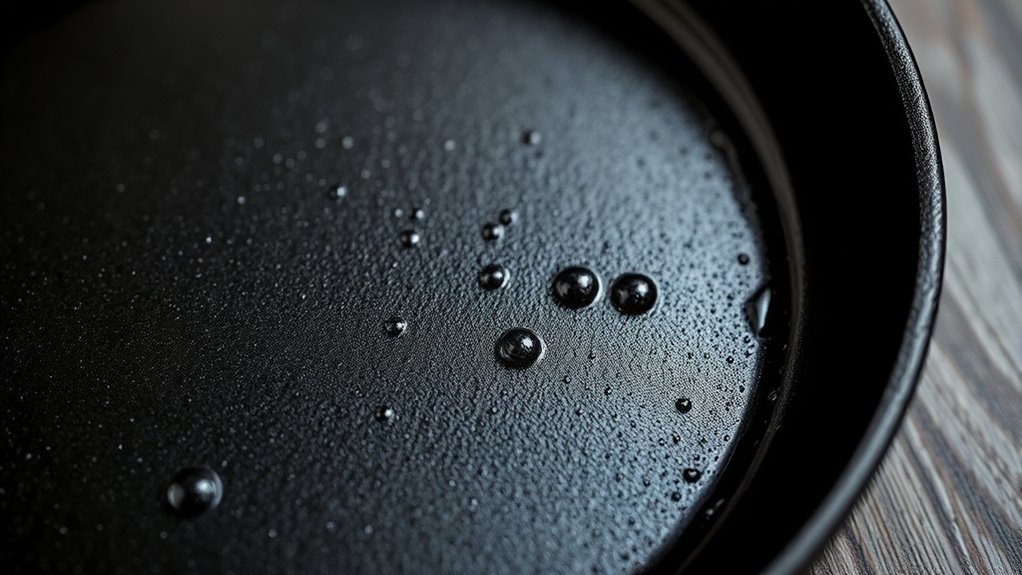
How many coats you need depends on achieving the right balance between durability and build-up. Generally, thin layers are better for even seasoning, but sometimes thicker coats create a more robust non-stick surface. Let’s explore the ideal number of coats and whether you should go for thin or thick layers. Also, understanding the importance of dog-friendly policies can remind us to maintain a comfortable environment for pets during cooking or cleaning activities.
Optimal Coat Count
Determining the right number of coats for your cast iron skillet is essential for achieving a durable, non-stick surface without wasting time or product. Generally, 3 to 4 coats strike a good balance, ensuring strong coat adhesion and ideal seasoning durability. Too few coats may result in a surface that wears quickly, while too many can lead to a sticky or uneven finish. Focus on building a solid foundation with layers that bond well, avoiding excess buildup. When applying coats, ensure each layer is thoroughly cured before adding the next. Properly managed coats improve seasoning durability and prevent flaking. Keep in mind, the goal is to develop a resilient, non-stick surface through a precise, moderate number of well-adhered layers, not an overly thick one. Additionally, understanding payment processing can help you secure your online transactions when purchasing cast iron or related supplies.
Thin or Thick Layers
The thickness of each coating plays a significant role in the quality and longevity of your cast iron’s seasoning. If you apply too thick a layer, the oil may not fully bond, leading to uneven seasoning and potential flaking. Conversely, a thin layer encourages better oil penetration and creates a more durable, smooth surface. When oil application is too heavy, excess oil can create sticky spots or uneven build-up, requiring more scrubbing later. Aim for a light, even coat each time you season your pan. Multiple thin layers build a robust seasoning without the risks associated with thick, uneven coatings. Remember, patience and proper layer thickness are key—less is often more when it comes to oil application for lasting seasoning. Using appropriate oils and maintaining proper application techniques can further enhance seasoning durability.
Common Mistakes That Damage Your Seasoning
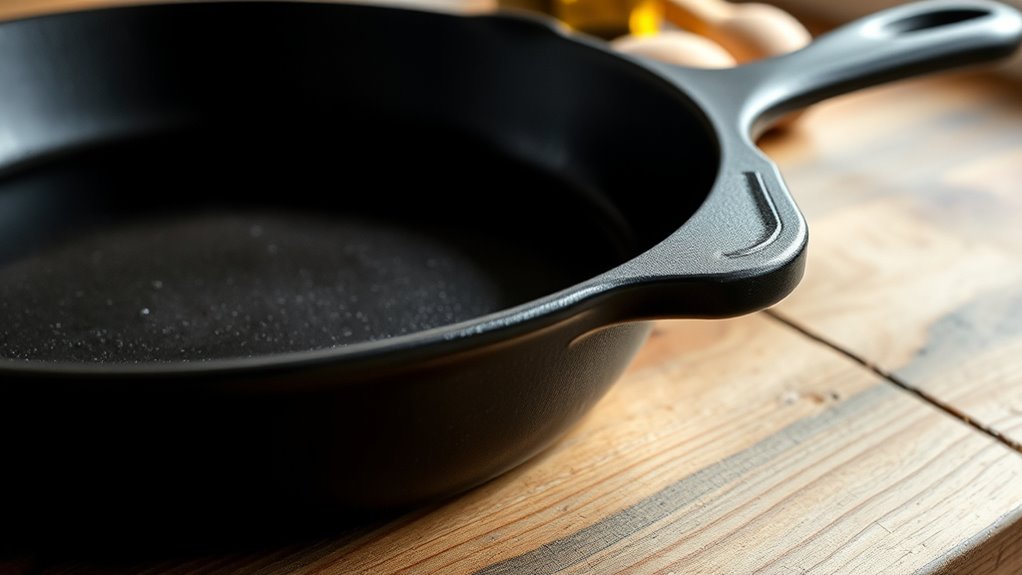
Many common mistakes can quickly ruin your cast iron seasoning, often without you realizing it. These seasoning mistakes lead to seasoning damage that’s hard to fix. For example, using soap frequently strips away the seasoning, weakening the protective layer. Overheating your pan causes the seasoning to break down or become uneven. Scrubbing with abrasive tools can remove layers, creating spots that rust. Additionally, improper cleaning and storage—like leaving it wet—accelerate damage. To avoid these pitfalls, keep these in mind:
- Avoid harsh soaps and abrasive scrubbers
- Don’t heat the pan beyond recommended temperatures
- Dry thoroughly after washing
- Store in a dry, protected environment
Staying mindful of these errors helps preserve your seasoning and ensures your cast iron lasts for generations.
Maintaining Your Seasoning: Daily Care vs. Deep Reconditioning
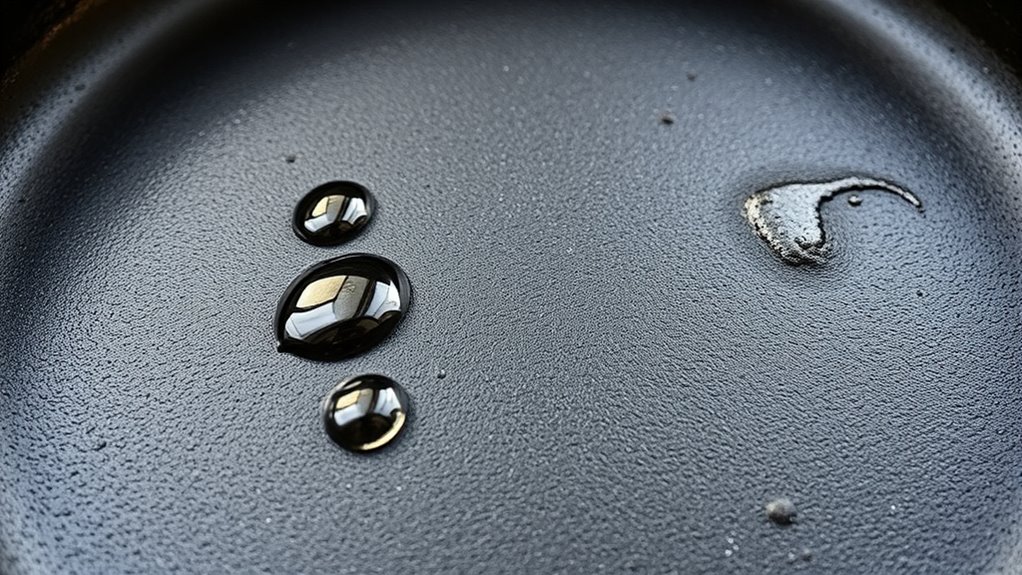
To keep your cast iron seasoned and performing well, you need to balance daily maintenance with occasional deep reconditioning. Daily care involves simple seasoning techniques like wiping with a light layer of oil after each use and avoiding harsh soaps. This consistent oil application builds and sustains a durable seasoning layer. For deeper reconditioning, you’ll want to strip any dull or damaged surface and reseason thoroughly, often with a high-smoke-point oil applied evenly before baking. Regularly maintaining your skillet prevents rust and preserves its non-stick qualities. Remember, daily seasoning techniques keep the surface protected, while deep reconditioning restores and renews the seasoning when needed. Both practices are essential for long-term performance and creating a naturally seasoned, reliable cooking surface.
Troubleshooting: Sticky, Rusty, or Dull Surfaces
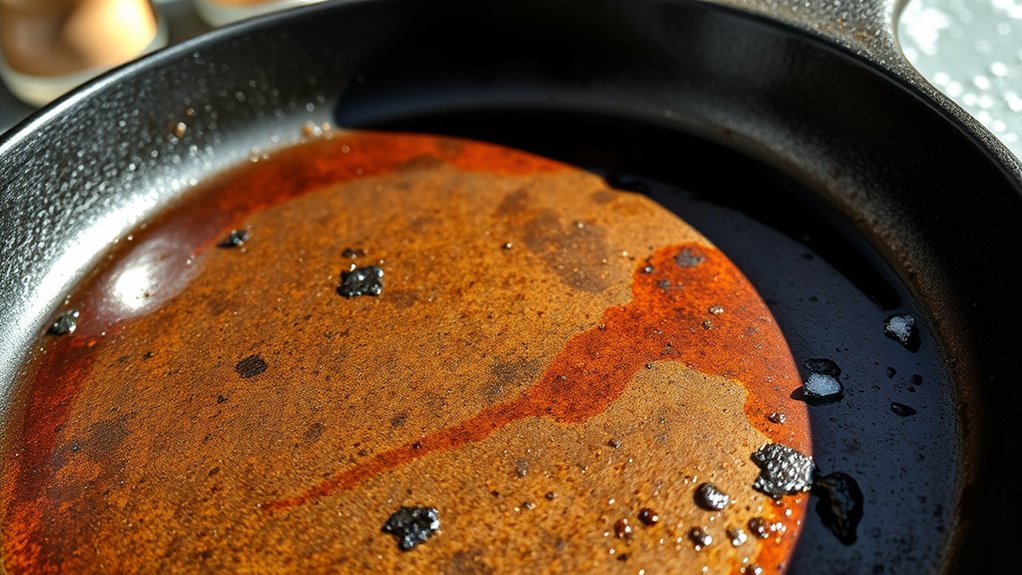
When your cast iron surface becomes sticky, rusty, or dull, it signals that your seasoning needs some attention. Sticky surfaces often result from excess seasoning build-up, while rust indicates neglect or moisture exposure. Dullness suggests insufficient seasoning or wear over time. To fix these issues:
- Use a stiff brush or steel wool for rust removal, ensuring all rust is gone.
- Strip the seasoning by applying a baking soda paste or oven cleaner, then rinse thoroughly.
- Re-season with a thin layer of oil, baking at 450°F for an hour to restore smoothness.
- Maintain regularly by cleaning and lightly oiling after each use to prevent future problems.
Addressing these problems promptly keeps your cast iron in top shape, ensuring a smooth, rust-free, and well-seasoned cooking surface.
Beyond the Basics: Enhancing Flavor and Longevity With Seasoning

Enhancing the flavor and longevity of your cast iron skillet goes beyond basic seasoning techniques; it requires mindful maintenance and thoughtful application of oil. To improve seasoning durability, regularly apply a thin layer of oil after use, ensuring it’s evenly distributed. This prevents oil absorption from creating uneven spots or sticky surfaces, which can weaken the seasoning over time. Using oils with high smoke points, like flaxseed or grapeseed oil, helps build a more resilient coating. Periodic re-seasoning sessions can also strengthen the surface, boosting both flavor and durability. Remember, consistent care with proper oil application not only enhances the skillet’s natural non-stick qualities but also prolongs its lifespan, turning your cast iron into a kitchen heirloom.
Frequently Asked Questions
Can You Season Cast Iron With Non-Stick Sprays?
You can technically use non-stick spray to season cast iron, but it’s not recommended for ideal seasoning effectiveness. Non-stick sprays often contain additives that can create a sticky or uneven coating over time. For better results, opt for oil with a high smoke point like flaxseed or vegetable oil, and apply thin layers. This approach ensures a durable, non-stick surface that improves with each seasoning layer.
How Often Should I Re-Season My Cast Iron Cookware?
Think of your cast iron as a loyal garden that needs regular tending. You should re-season it every few months or when you notice rust, sticking, or loss of non-stick properties. For best maintenance tips, clean it gently, dry thoroughly, and apply a light coat of oil before storing. Regular seasoning keeps your skillet performing like a well-oiled machine, ensuring it stays rust-free and ready for your next culinary adventure.
Does Soap Ruin a Seasoned Cast Iron Surface?
Soap cleaning doesn’t ruin a seasoned cast iron surface if you do it occasionally and use mild soap. It can remove built-up residue without stripping the seasoning if done carefully. Avoid harsh scrubbing or using non-stick sprays, which can damage the seasoning over time. Instead, rinse with hot water, scrub gently if needed, and reapply a light coat of oil afterward to maintain your cast iron’s non-stick qualities.
What’s the Best Way to Remove Rust From Cast Iron?
To remove rust from cast iron, start with rust removal techniques like scrubbing with steel wool or a vinegar soak. Afterward, rinse thoroughly and dry completely. Then, restore your seasoning by applying a thin layer of oil and baking it in the oven. This process helps eliminate rust and rebuilds that protective, non-stick surface, keeping your cast iron in great shape for years to come.
Can I Season Cast Iron in the Oven or on the Stovetop?
Did you know that over 80% of home cooks prefer oven seasoning for cast iron? You can absolutely season cast iron in the oven or on the stovetop. Oven seasoning provides a deep, even layer, while stovetop seasoning is quick and convenient. For oven seasoning, preheat to 400°F and bake for an hour. Stovetop seasoning involves heating the pan and applying oil until it’s glossy—both methods work great!
Conclusion
Think of your cast iron as a garden—you nurture it with care, patience, and the right tools. Each layer of seasoning is like planting seeds that grow stronger with time. With consistent effort, your skillet will flourish, offering delicious meals and lasting memories. So, keep tending to your cast iron, and watch it transform from a simple tool into a treasured heirloom—blooming with flavor and history with every use.
